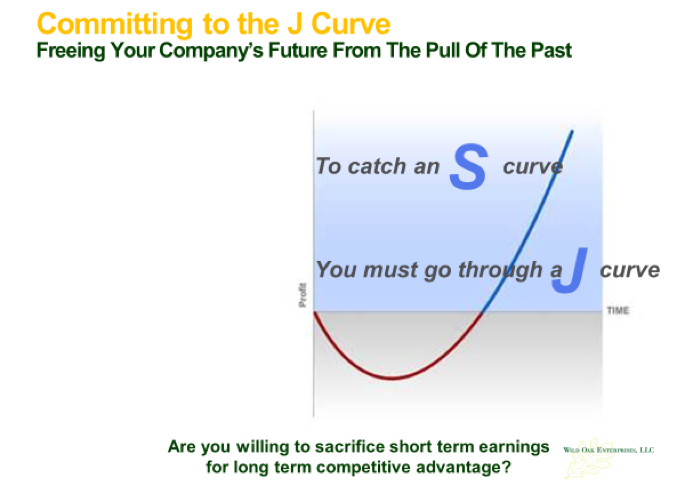
August 24, 2018
In the digital world,
success requires a willingness to pivot.

A true pivot is a fundamental change in the way a company delivers value
It’s virtually impossible to read anything business related today and not run across a call to arms for digital transformation. While there is still significant debate about what is digital transformation, one common denominator is that it represents a major shift in how a company delivers value to its customers, employees, supply chain partners and other key stakeholders.
To successfully execute a core value proposition pivot represents one of the greatest leadership challenges senior executives and their teams have faced in several decades. Not only does this shift challenge long held beliefs about what has made a company successful but it also calls into question what are the relevant skills and capabilities needed to compete as a digital enterprise.
As my brother, Geoffrey Moore said in his book Escape Velocity, “freeing your company’s future from the pull of its past” will be the differentiating factor between success and failure for companies of all sizes across all industries.
When push comes to shove, certainty defeats unpredictability

In most companies, short term earnings still trump long term opportunities. Senior business leaders are incentivized to deliver consistent revenue and earnings growth quarter after quarter after quarter. It’s not until those earnings come under existential threat that serious consideration is finally given to rethinking the company’s operating and business model.
As I have written in an earlier blog, there are four questions you can ask to start to even the odds between certainty and unpredictability.
- How long can the company’s current business model deliver its desired business growth goals and financial results?
a. How sustainable are the company’s revenues, margins and profits? - How vulnerable is the company’s business model to being digitally disrupted?
a. How quickly could the company respond to this digital disruption? - How well can the company leverage digital technology for increased competitive advantage?
a. How robust is the company’s digital technology pipeline? - How open is the company’s culture to changing the way it does business?
a. How capable is the company at competing as a digital enterprise?
The market actually rewards long-term value over short term performance

The McKinsey Global Institute estimates that 75% of the U.S. market is held by buy-and-hold investors who are actually interested in the long-term value of the companies they’ve invested in. They also examined the performance of 615 large and mid-cap U.S. publicly listed companies from 2001 to 2015 and found:
- The revenue of long-term firms, which spent on average 50% more on R&D, cumulatively grew on average 47% more than the other firms and with less volatility
- Cumulatively, the earnings of long term-term firms also grew 36% more on average
When Satya Nadella took over as CEO at Microsoft, one of his early moves was to pivot the Office Business from an on-premise on-desktop business model that was a dependable short term earnings juggernaut to a Cloud-first – Mobile first business model that was showing modest growth potential competing against Amazon Web Services. The business was generating $5 billion in revenues and Satya set a three year goal of $20 billion. In the first quarter of this year, he announced that the business had surpassed that goal 9 months ahead of schedule and the market has nearly tripled the price of its stock in that time period.
Why it’s hard for established companies to commit to the J Curve
The reason most well-established companies struggle to commit to pivoting to a new way of delivering value to its customers is that they don’t have the resolve and discipline to redirect scarce resources from funding short term returns vs. long term opportunities.
Venture capitalists call this investing in the J Curve to catch the S Curve as shown below:

Most well established companies are unwilling to take on the risk of lower short term earnings over an extended time period in order to allow the new customer value proposition enough time to produce higher long term results. When they are willing to do so, the results are more than worth the risk as the example below suggests.
In 2013, Adobe Systems embarked on a major transition from a product/license sales model to a cloud -based subscription model. Revenue shrank 8% in the first year and was basically flat in 2014. The skeptics’ and naysayers’ voices rang loud and clear.
Fortunately, the senior leadership team at the company along with the board stayed true to their intent and Adobe’s revenues reached nearly $6 billion in 2016 up from $4 billion in 2013. Eighty percent of those revenues came from subscriptions and other recurring sources.
Some things to consider to execute a successful pivot

- Raise your company’s digital acumen: Uncertainty feeds off a lack of knowledge and understanding about what’s new and what’s possible. To lower uncertainty, create a continuous learning program to enable your board, executive committee and senior leadership teams to better understand the scope and disruptive impact new digital technologies can have on your company.
- Engage with early adopters: Seek out opportunities to meet with executives from companies like Adobe and Microsoft who have engineered successful pivots and see what you can learn from them. They likely faced the same operating and cultural challenges you are so learning how they overcame them will be invaluable.
- Change your compensation structure: It’s a cliché but still very true – people do what they get paid to do. If you’re still incentivizing business units to only deliver short term returns then you can’t expect them to commit to redirecting resources to longer term payout initiatives. Every sales person I know is primarily motivated by a desire to “make club.”
- Develop a compelling narrative for the market: As the statistics highlight, the market does like and will reward successful pivots that deliver long term value. As such, be very clear about your intentions and your game plan to successfully realize those intentions.
Making a pivot of this magnitude and impact not only requires strong leadership and resolve but a desire to demonstrate the true potential and capability of your organization. While it certainly entails significant risk, it also acknowledges that those who can execute a successful pivot will be the winners in the new age of digital disruption.
As always, I am interested in your comments, feedback and perspectives on the ideas put forth in this blog. Please e-mail them to me here. And, if this content could be useful to someone you know please share it here:

